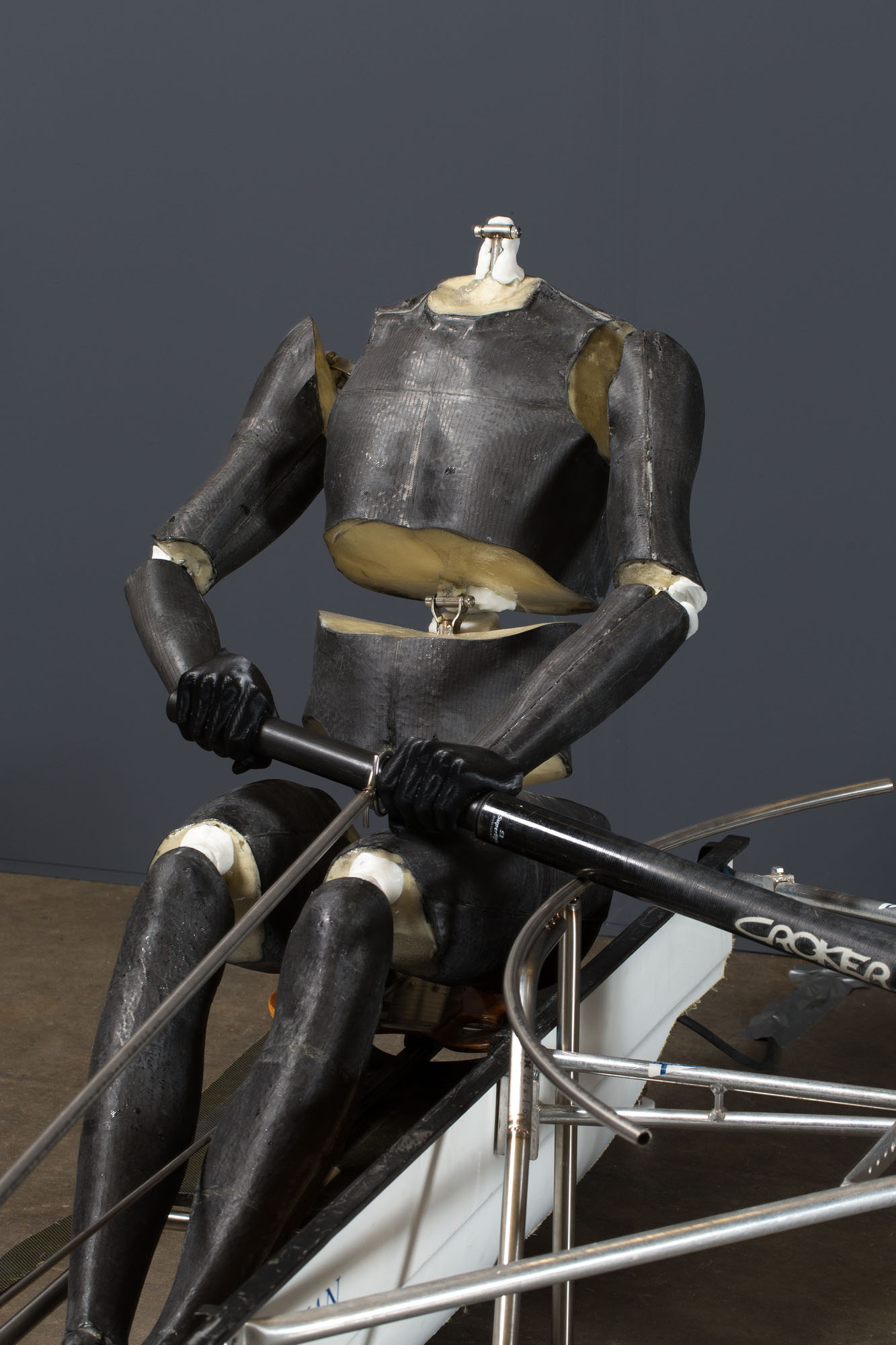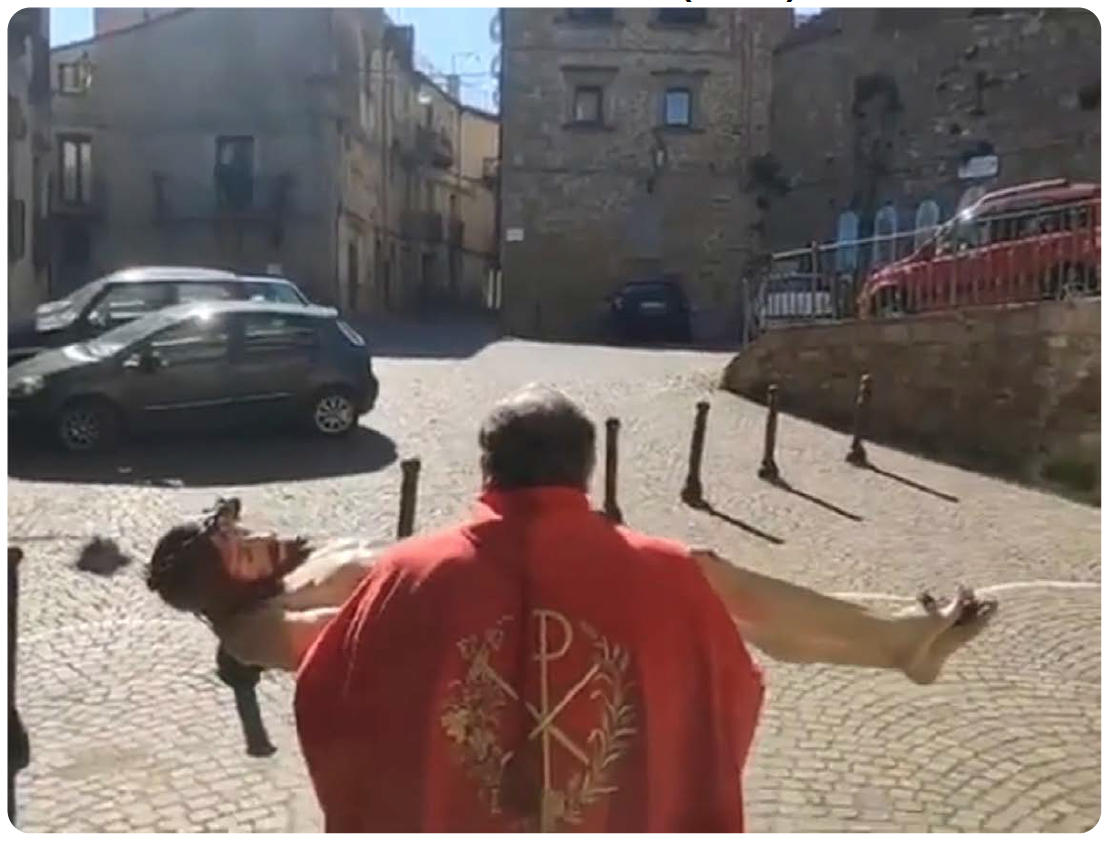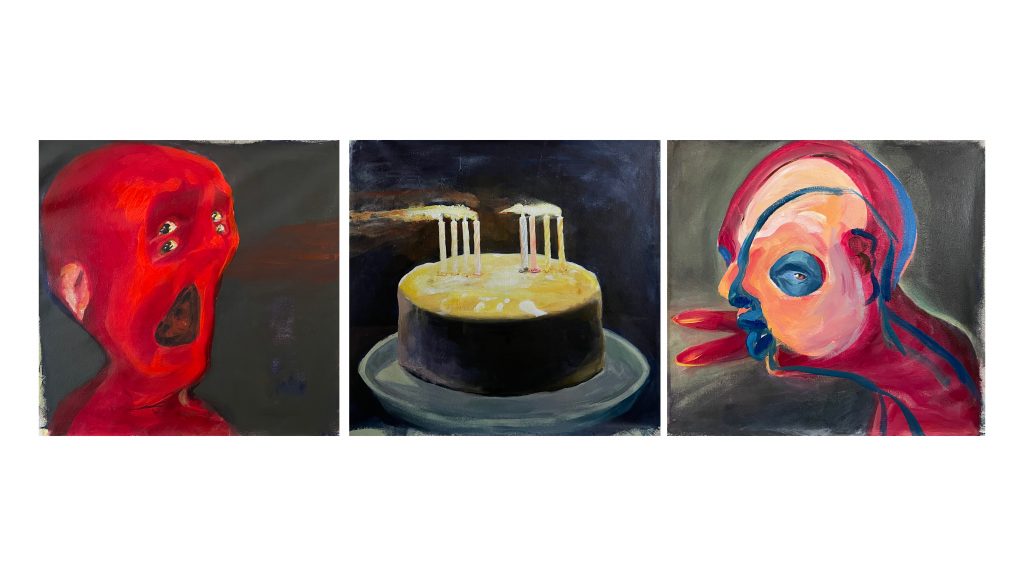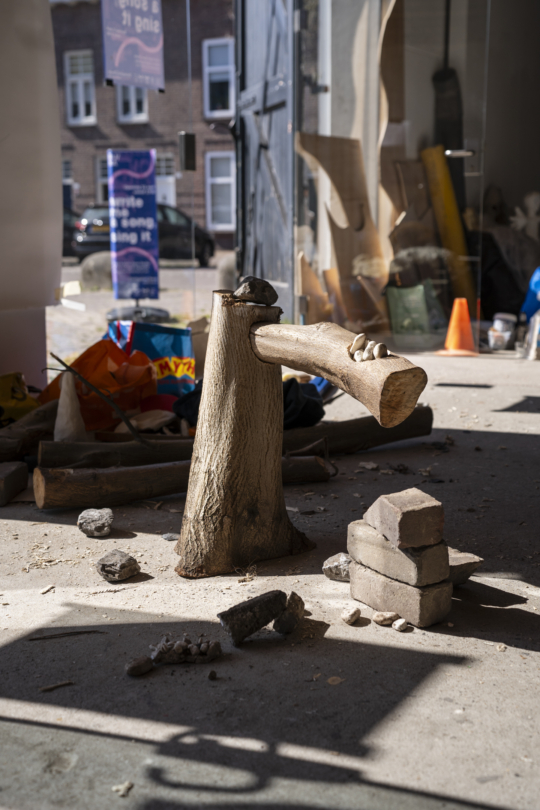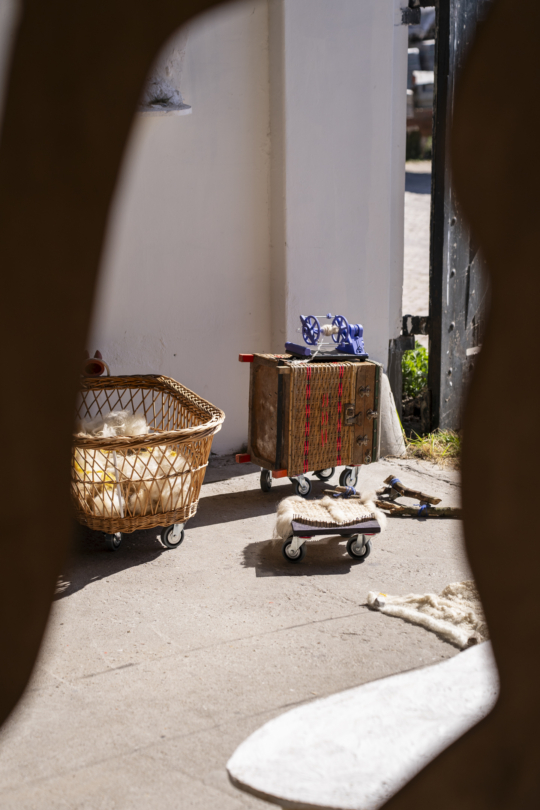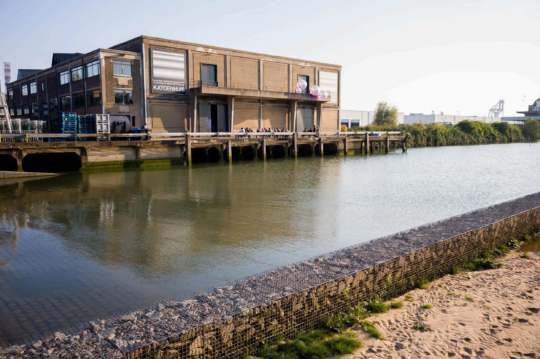
‘OMG GOOD COCK AND BAD COCK BROKE INTO MY EXHIBITION!’ – NELLY DANSEN
Between May 22nd and 24th, I staged my piece Smile :) You’re on Camera behind a glass window at the Geldersekade, as part of ‘The Living Room’ series curated by performance collective Trespassing: A series of performative interventions in the (semi-)public space that navigate between the thresholds of the private and public, exhibitionism and voyeurism, and of social cohesion and estrangement (what a mouthful of a sentence). By ways of aesthetic disruption, The Living Room series invites onlookers to linger a little longer whilst they are encouraged to contemplate upon the questions posed behind these windows.
Earlier this year in April, I showed my video work GOOD COCK BAD COCK at the same space, a short film I made after getting deported from the United States when my film Head Over Heels raised some suspicion. I missed the opening of that event because I was kettled by police with a group of other protesters during a peaceful pro-Palestine march on the Zuidas…(a gentle reminder that control operates not only through surveillance technology but also through state power and policing. BUT! We will dive into that later…)
All too often, my work collides with The System™. On the opening night of May 22nd, I was actually on time for once (history was made). But so were some uninvited guests, arriving fashionably early and dressed in full authoritarian chic: The Cops™. Oink Oink.
The installation
‘Smile :) You’re on Camera’ was a three-day-long performance installation, positioned right in the center of a front window that faced the street. It featured a live-feed surveillance camera mounted outside the building, projecting real-time footage of passersby and visitors onto a TV screen placed inside the space. This simple setup flipped the gaze: turning viewers into the viewed, spectators into spectacle. On the walls of the room, posters of Foucault, Orwell, and Deleuze hung like silent overseers, framing the work in Theoretical Tension™ and inviting the audience to reflect on power, control, and visibility.
I draped myself in the room too, performing the role of a visible Big Brother, watching people on the screen while simultaneously watching Big Brother USA, season 12 from the comfort of my own Surveillance Man Cave™ (whatever that means…).
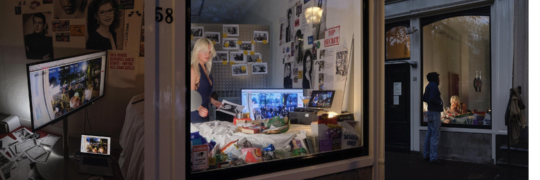
The installation used camp aesthetics to exaggerate traditional Surveillance Vibes™ like CCTV, but ultimately, it pointed toward something more intimate: the internalized surveillance many of us carry. Though for some, it starts earlier and runs deeper. Especially if you’ve moved through the world in a body that was always already being watched.
“The surveyor of woman is herself male: the surveyed female. Thus she turns herself into an object, and most particularly an object of vision: a sight.” – John Berger, Ways of Seeing
That quote resonates deeply, but for me, in the words of my friend Matilda, it resonates even more:
“I was thinking of surveillance today, and how I really don’t care about being surveilled, but a bunch of guys do. So classic, women have been self-surveilling since the dawn of their puberty. Who cares about a bunch of cameras watching you when you are always already watching yourself?” – Matilda Elofsson, Whatsapp Chitchattery
Literally.
Now, in the digital age, that gaze is even harder to escape and often it also lives inside our own minds. We curate and package ourselves. That logic of visibility, of managing one’s appearance in a performative loop, wasn’t just something I was thinking about during the making of this work. It was literally taped to the wall.
The surveillance camera I used was no fancy-schmanzy, high-tech security device. It was a cheap thing, duct-taped outside of the gallery like a last-minute solution, or a desperate attempt at control. It didn’t scream authority and that was exactly the point. By choosing a visibly visible crappy setup, I wanted to strip the surveillance aesthetic of its usual invisibility. No seamless or sleek angles. Just exposed cables and tape. A kind of bimbo-bureaucracy aesthetic… Ohhh how I <3 Duct-tape…
The footage fed into a basic TV screen inside the space, not a monitor like in a control room, but something more domestic and DIY. Visitors saw themselves as lo-fi versions Beamed into my Bedroom. This broken infrastructure mirrored how we self-surveil: imperfectly, obsessively, without knowing if anyone’s even watching. The absurdity of a taped-up camera surveilling people who voluntarily stop and look at themselves, in an artwork that critiques that very gaze, created the loop I was after.
As I said, I was part of it too: lounging inside my bedroom slash Surveillance Man Cave™, watching Big Brother USA while occasionally peeking at the surveillance feed. Authority, NELLY DANSEN: Head of Gaze Operations, was disinterested, performative and half-watching. And that felt true. Because most of the time, no one is really watching. We’ve just learned to behave as if they are. Even a duct-taped system still makes us pause, do a posture correction, and check how we’re seen. Even duct-tape DIY surveillance still works.
The Gaze
That feedback loop of visibility, being the watcher and the watched, is what I really wanted to explore. Not just as a metaphor, but as something I’ve been living through, especially in relation to NELLY DANSEN: the performative persona I created, who lives both online and offline. At first, I thought I was constructing her, shaping her identity as a tool, a persona, a character. But at some point, the dynamic shifted. It started to feel like she was creating me. That’s the paradox of identity today; especially when it’s performed, archived and mirrored back. You become the observer and the observed.
Observation and visibility is never neutral; it always carries power dynamics. It shapes how we’re perceived and eventually, how we perceive ourselves. I remember working at a nightclub where one of the house rules was something along the lines of “don’t stare at someone too long, it can be intrusive ”. That rule really stuck with me. Also in a club context, the gaze was recognized as something with weight, something that could cross a line. I wanted to explore that same logic during the performance. It wasn’t just a campy performance of surveillance; it mirrored how deeply “being watched” is woven into all aspects of our lives, and how uncomfortable that presence can feel. The gaze doesn’t need to be a high-tech surveillance camera to be powerful. It just needs to be there.
The Shift
And then, suddenly, that violence I was reflecting on showed up right at my doorstep.
During the final prep, half an hour before the opening of SMILE :) You’re on Camera, a man was stabbed right outside the gallery. Later, he was shot in the leg further down the street. Police showed up quickly and blocked off the entire area. Luckily, the victim is physically okay, but the whole situation shattered the distinction between performance and reality within a second.
From inside the space, we watched everything unfold in real time through the surveillance camera I set up as part of the work, making for a disturbingly dystopian moment. What happened went beyond performance.
But it also expanded the performance, wildly. Up until then, my work focused on surveillance as a metaphor, especially how it shapes femininity, performance, and the internalized gaze. But what happened outside opened it all up. Suddenly, it wasn’t just about being watched, but about surveillance as state power: as policing and as control.
There’s an irony here that can’t be overlooked: one of the main arguments in favor of CCTV and surveillance is that it helps police catch criminals and ‘keep us safe’. Yet at this moment, my installation ended up becoming part of that system, blurring the line between critique and complicity.

After things settled, we walked outside for a bit to decompress. When we came back, we found that the police had entered the gallery without our permission (…the real trespassers). One cop even admitted his surprise to finding that the presenting artist was female. “This has a very masculine look,” he continued. They stood beneath the Orwell poster (who they apparently thought was Elvis Presley), flipped through the July 2024 Playboy featuring me on the cover, and walked right over my printed-out surveillance footage. The installation, which looked like an absurdist explosion of surveillance evidence, was now being treated as actual evidence. IT specialists tried to pull footage from the surveillance camera; which ultimately failed (Ha!! Their power is not absolute!) , and I was informed that they would try again in the morning. Which failed again…
As I’ve lovingly referred to her before: my Crappy Camera was one bought online for cheap. Turns out; the camera had been blacklisted for use in Dutch government buildings because it streamed directly to a cloud server somewhere in China and had no internal storage. All the authority… all the urgency… undone by a cheap camera with no hard drive. My installation may have looked like evidence, but its real function was revelation. Not of crime, but of fragility. The state came looking for clarity, and was met with duct-tape, bad WiFi, and a cloud server I didn’t even know existed.

And yet… There I stood that night; still shaken by what happened outside, standing in my own installation surrounded by cops. At that point, the staged reversal of power fell apart. C’est moi, The Artist, got turned into data custodian under the watchful eye of the state. While I positioned myself in the work as Head of Gaze Operations, the ‘real’ gaze; the authoritarian gaze, showed up in uniform.
The irony dripped like …
The whole thing felt Baudrillardian: the line between simulation and reality completely disappeared. In other words, what was supposed to be a critical performance blended right into the real-world system it was critiquing. A hyperreal moment where both folded into one.
The room watched.
The room was watched.
The gaze became real, not just symbolic.
This wasn’t the opening night anyone expected.
But somehow, it reveals truths clearer than any script could.
The Aftermath
Shortly after the incident, Het Parool covered the story. The article ended with the line that installation became officially part of the full police investigation. Which added some extra gravity; seeing it written out like that in the newspaper. It was now public and archived in official history.
And to be honest, I was relieved the footage wasn’t saved. Not just because the tech failed, but because I didn’t feel like intervening or assisting law enforcement. The situation outside was complex, and I didn’t feel comfortable handing over data that could criminalize people, especially when they looked so young. This exposes the lie at the heart of the “CCTV keeps us safe” argument. Safe for who? Surveillance doesn’t guarantee justice, it enforces power. It captures what’s useful to the state and discards what isn’t.
The Bias
What stayed with me after the whole thing wasn’t just the chaos, it was the question of who gets protected, and who gets erased. Surveillance isn’t just about watching; it’s about deciding what gets seen, what gets saved, and what gets deleted. It’s a tool of power, not justice.
While the state will extract footage from a gallery (without asking), it’s also perfectly capable of deleting it when violence doesn’t serve the oppressor’s narrative.
Look at the recent news about ‘lost’ CCTV footage of the Maccabi supporters attacking people in Amsterdam in November 2024. A woman shouted “Free Palestine” in a metro station and was violently attacked; hit, spat on, and had her hair pulled by some of the Tel Aviv soccer club hooligans. She later gave a formal statement detailing the assault. The entire incident was caught on camera. And yet, for some very suspicious reason, the footage was deleted by the GVB…
How convenient…
What this highlights is another larger truth about surveillance. Surveillance isn’t neutral memory-keeping. It’s actively forgetting when the narrative doesn’t serve power. It archives selectively, to punish some, and protect others.
The End
Right now, I’m sitting in the canteen of De Leeuwarder Courant, writing this article (while Gasolina blasts through the speakers… Can a girl focus??). It’s unofficial ‘Bring Your Child to Work Day’ as I’m visiting my mom. While she wraps up some things for the paper, I’m here writing this piece, as an artist-posing-as-article-writer, in a newspaper office.
Another hyperreal moment. Watching myself write about watching, inside a place that literally becomes public record.
I guess that is the full circle. I started this piece as an installation, then it turned into an investigation and now I am documenting and archiving it in a newsroom.
Artist / Persona
Gallery / State
Critique / Complicity
Performance becomes Evidence.
Art becomes Archive.
The line blurs, again.
XOXO,
NELLY DANSEN
PS. Big Boobies Are Watching You!
References
Books and Theorists:
- Foucault, Michel. Discipline and Punish: The Birth of the Prison. Vintage Books, 1977.
- Orwell, George. 1984. Secker & Warburg, 1949.
- Deleuze, Gilles. “Postscript on the Societies of Control.” October, vol. 59, 1992.
- Berger, John. Ways of Seeing. BBC and Penguin Books, 1972.
- Baudrillard, Jean. Simulacra and Simulation. University of Michigan Press, 1994 (original 1981).
- Eloffson, Matilda. Whatsapp Chitchattery. Whatsapp, 2025.
News Articles:
- Het Parool. “Kunstwerk dat openbare camera’s bekritiseert, legt steekpartij vast”. Olaf Heyblom, 26th of May 2025.
- De Volkskrant. “Mishandelingszaken rond Maccabi-fans geseponeerd na gewiste ov-beelden, advocaat eist onderzoek”. Loes Reijmer, 16th of June 2025.
- Nu.nl. “Twee onderzoeken naar Maccabi-fans gestopt omdat ov-beelden al waren gewist”. NU Nieuws Redactie, 15th of June 2025.





